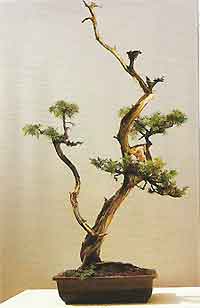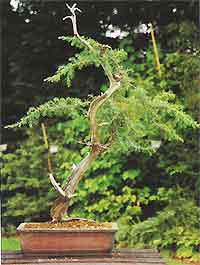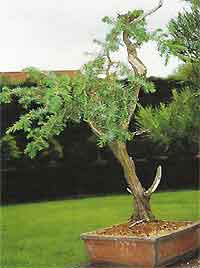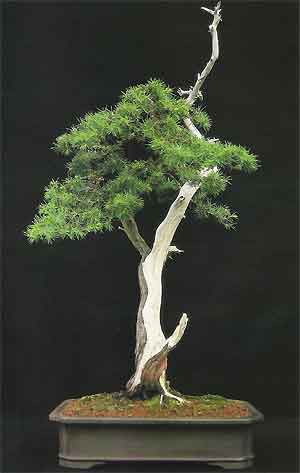Bonsai Trees
Case Histories
Needle Juniper - (juniperus rigida)
Needle Juniper Bonsai Style: Driftwood

I first noticed this needle juniper whilst visiting a bonsai nursery one spring. Recently imported from Japan it was obviously suffering, with the foliage being very yellow and weak. It was tucked at the back corner of a large group of lush green needle junipers and, to my good fortune, was going unnoticed.
I could see that the tree had great potential, indeed if it lived it could probably become the finest needle juniper there. The driftwood had a dramatic, flowing shape, the trunk was solid and the base was good. However, the branch structure was poor and there was an odd second trunk that was begging to be removed.

The foliage mainly consisted of three small pads of pale growth, much of it dead with no signs of any new buds. I began to see the chance of a bargain and convinced myself that even if the tree did not survive, I would be left with an excellent piece of driftwood!
Capitalizing on the tree's general ill-health and sad appearance, a deal was struck. I would not normally recommend such action, but the tree had fired my imagination and I had always wanted a quality needle juniper!
Needle Juniper Bonsai History: Training
I thought that the tree had been traumatized by its recent long journey and decided to leave repotting until next year when it was stronger, hopefully. It was kept under cover, out of the rain as the sodden soil indicated poor drainage. I therefore watered very carefully. After about four weeks, to my delight some new green buds started to appear on the top of both trunks.

However, the important lower branch continued to deteriorate with no signs of life. I began to worry that the top of the strange second trunk may be sapping energy from this branch, and so off it came, leaving behind a nice jin. The highest branch continued growing, albeit slowly, but the main lower branch began to turn more yellow and soon died.
I inspected the roots and was horrified to see how potbound this sorry tree was. There were roots over 1 1/2 metres (5 feet) long, just coiled round and round the bottom of the pot. I was annoyed at myself for not checking them in the spring and immediately transplanted the tree into a larger pot, not root pruning as it was early summer.
The tree was root pruned and repotted in the spring, then fed heavily for the next four years. The surviving branch grew well, giving the tree much needed strength. At this stage I began to study the tree from all angles and discovered a new front, one that I'd never noticed before as I had previously selected the front when the tree still had its lower branch. There was a problem though - the top of the driftwood was strongly angled backwards and to the right, throwing the balance. Maybe this could be corrected by using a heat bending technique.

This method of steam bending dead wood is commonly used in furniture making. I wrapped the area of dead wood needing to be bent with wet tissue and then tightly bound with aluminium foil. The live area of the tree was protected with more foil and I proceeded to move a lighter flame around the sealed area. The water in the tissue soon began to boil and steam started to appear.
After ten minutes I carefully began bending the top of the trunk which had become surprisingly pliable. I tied the tip in place with wire, unwrapped the foil and tissue and dried the area with the flame. The wire was removed and the upper trunk remained in its new chosen position. I had successfully bent the dead wood more than 8 cm (3 inches), transforming the whole tree. There was now so much foliage from the one remaining branch that I was able to treat it as a high secondary trunk. I wired everything and positioned several nicely shaped sub-branches. At last I was getting somewhere with this tree.
The tree is still in early development and needs much refinement, but the structure is there - and even more importantly, so is good health and vigour!
 I first noticed this needle juniper whilst visiting a bonsai nursery one spring. Recently imported from Japan it was obviously suffering, with the foliage being very yellow and weak. It was tucked at the back corner of a large group of lush green needle junipers and, to my good fortune, was going unnoticed.
I first noticed this needle juniper whilst visiting a bonsai nursery one spring. Recently imported from Japan it was obviously suffering, with the foliage being very yellow and weak. It was tucked at the back corner of a large group of lush green needle junipers and, to my good fortune, was going unnoticed. The foliage mainly consisted of three small pads of pale growth, much of it dead with no signs of any new buds. I began to see the chance of a bargain and convinced myself that even if the tree did not survive, I would be left with an excellent piece of driftwood!
The foliage mainly consisted of three small pads of pale growth, much of it dead with no signs of any new buds. I began to see the chance of a bargain and convinced myself that even if the tree did not survive, I would be left with an excellent piece of driftwood! However, the important lower branch continued to deteriorate with no signs of life. I began to worry that the top of the strange second trunk may be sapping energy from this branch, and so off it came, leaving behind a nice jin. The highest branch continued growing, albeit slowly, but the main lower branch began to turn more yellow and soon died.
However, the important lower branch continued to deteriorate with no signs of life. I began to worry that the top of the strange second trunk may be sapping energy from this branch, and so off it came, leaving behind a nice jin. The highest branch continued growing, albeit slowly, but the main lower branch began to turn more yellow and soon died. This method of steam bending dead wood is commonly used in furniture making. I wrapped the area of dead wood needing to be bent with wet tissue and then tightly bound with aluminium foil. The live area of the tree was protected with more foil and I proceeded to move a lighter flame around the sealed area. The water in the tissue soon began to boil and steam started to appear.
This method of steam bending dead wood is commonly used in furniture making. I wrapped the area of dead wood needing to be bent with wet tissue and then tightly bound with aluminium foil. The live area of the tree was protected with more foil and I proceeded to move a lighter flame around the sealed area. The water in the tissue soon began to boil and steam started to appear.